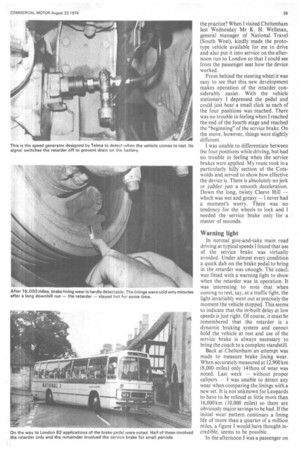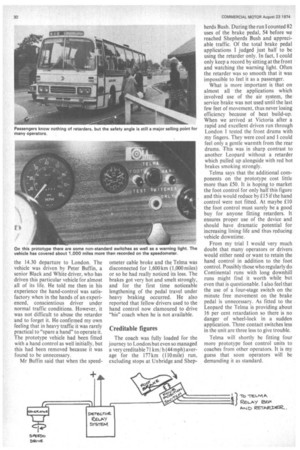Putting the boot in.
Page 32

Page 33

Page 34

If you've noticed an error in this article please click here to report it so we can fix it.
On the road with Telma's new pedal control system
by Martin Hayes; • • photographs by Dick Ross AN AUTOMATIC control system mounted on the foot brake pedal and operating Telma's electric retarder is now in trial service on a Leyland Leopard/ Duple Dominant coach operated by National Travel (South West) Ltd (Black and White). The prototype unit has been developed by Telma in the UK for use instead of, or in addition to, the conventional fourstage, column-mounted, hand-control. Last week I had an exclusive opportunity to try the device for myself and to see how it performed under service conditions.
Telma has developed the new device in a bid to answer criticisms by some operators that the hand-control can mean that the retarder is not used at all or is used improperly. By putting the control on the foot brake pedal it is claimed that the electro-magnetic retarder is fully utilized while guarding against driver abuse.
In the prototype installation the retarder is quite unaffected. The only changes are the use of a four-stage mechanical plunger switch fitted into the initial travel on the brake pedal, a speed generator and a standstill detector relay system. These two last items, designed by Telma but manufactured by Icknield Instruments, are necessary to switch the retarder out at speeds below walking pace.
In the past there have been cases of drivers leaving the hand control switched on while the vehicle is stationary and so draining the battery. For the same reason (the retarder absorbs 2.5kW) it is undesirable to have the retarder operating at low road and engine speeds when the electrical generator is barely charging. Thusthe use of a standstill generator driven from the speedometer drive. This generator feeds a simple relay system which disconnects the retarder 1sec after vehicle speed falls to 4km/ h (21/2mph) ' and reconnects it when the speed rises over 7.7km/ h (4.8mph).
Little trouble The first vehicle to be fitted with the foot-control device has now completed more than 24,000 km (15,000 miles) in varied operation from its base at Cheltenham. At that depot the entire fleet of 32 Leopards is equipped with Telma retarders whiph, according to National Travel (South West) chief engineer, Trevor Vellacott, have given very little trouble. Brake lining life has been extended while the additional safety offered is welcomed.
I have always felt that a driver's natural reaction when some hazard develops on the road is to go first for the brake pedal. Driving coaches fitted with the Telma I have frequently touched the pedal — causing unnecessary and expensive lining wear — before remembering to flick in the columncontrol. Some operators have also been reluctant to present drivers with yet another control to operate. What with gear lever, indicator, lights, wipers and so on it is often difficult to find enough hands to steer with The addition of a further control makes the problem worse and it is interesting that some Natonal Bus Company subsidiaries have said that they will not install Telma retarders until the hand control is done away with.
So much for the theory, what about the practice? When I visited Cheltenham last Wednesday Mr K. H. Wellman, general manager of National Travel (South West), kindly made the prototype vehicle available for me to drive and also put it into service on the afternoon run to London so that I could see from the passenger seat how the device worked.
From behind the steering wheel it was easy to see that this new development makes operation of the retarder considerably easier. With the vehicle stationary I depressed the pedal and could just hear a small click as each of the four positions was reached. There was no trouble in feeling when I reached the end of the fourth stage and reached the "beginning" of the service brake. On the move, however, things were slightly -ddi different.
I was unable to differentiate between the four positions while driving, but had no trouble in feeling when the service brakes were applied. My route took in a particularly hilly section of the Cotswolds and served to show how effective the device is. There is absolutely no jerk or judder just a smooth deceleration. Down the long, twisty Cleeve Hill — which was wet and greasy I never had a moment's worry. There was no tendency for the wheels to lock and I needed the service brake only for a matter of seconds.
Warning light
In normal give-and-take main road driving at typical speeds I found that use of the service brake was virtually avoided. Under almost every condition a quick dab on the brake pedal to bring in the retarder was enough. The coach was fitted with a warning light to show when the retarder was in operation. It was interesting to note that when coming to rest, say, at a traffic light, the light invariably went out at precisely the moment the vehicle stopped. This seems to indicate that the in-built delay at low speeds is just right. Of course, it must be remembered that the retarder is a dynamic braking system and cannot hold the vehicle at rest and use of the service brake is always necessary to bring the coach to a complete standstill.
Back at Cheltenham an attempt was made to measure brake lining wear. When accurately measured at 12,900 km (8,000 miles) only 14 thou of wear was noted. Last week — without proper calipers -I was unable to detect any wear when comparing the linings with a new set. It is not unknown for Leopards to have to be relined at little more than 16,000 km (10,000 miles) so there are obviously major savings to be had. If the initial wear pattern continues a lining life of more than a quarter of a million, miles, a figure I would have thought incredible, seems to be possible.
In the afternoon I was a passenger on the 14.30 departure to London. The vehicle was driven by Peter Buffin, a senior Black and White driver, who has driven this particular vehicle for almost all of its life. He told me then in his experience the hand-control was satisfactory when in the hands of an experienced, conscientious driver under normal traffic conditions. However, it was not difficult to abuse the retarder and to forget it. He confirmed my own feeling that in heavy traffic it was rarely practical to "spare a hand" to operate it. The prototype vehicle had been fitted with a hand control as well initially, but this had been removed because it was found to be unnecessary.
Mr Buffin said that when the speed ometer cable broke and the Telma was disconnected for I ,600 km (1,000 miles) or so he had really noticed its loss. The brakes got very hot and smelt strongly, and for the first time noticeable lengthening of the pedal travel under heavy braking occurred. He also reported that fellow drivers used to the hand control now clamoured to drive "his" coach when he is not available.
Creditable figures
The coach was fully loaded for the journey to Londonbut even so managed a very creditable 71 km/ h (44 mph) average for the 177 km (110 mile) run, excluding stops at Uxbridge and Shep herds Bush. During the run 1 counted 82 uses of the brake pedal, 54 before We reached Shepherds Bush and appreciable traffic. Of the total brake pedal applications I judged just half to be using the retarder only. In fact, I could only keep a record by sitting at the front and watching the warning light. Often the retarder was so smooth that it was impossible to feel it as a passenger.
What is more important is that on almost all the applications which involved use of the air system, the service brake was not used until the last few feet of movement, thus never losing efficiency because of heat build-up. When we arrived at Victoria after a rapid and excellent driven run through London I tested the front drums with my fingers. They were cool and I could feel only a gentle warmth from the rear drums. This was in sharp contrast to another Leopard without a retarder which pulled up alongside with red hot brakes smoking strongly.
Telma says that the additional components on the prototype cost little more than £50. It is hoping to market the foot control for only half this figure and this would reduce by £15 if the hand control were not fitted. At maybe £10 the foot control must surely be a good buy for anyone fitting retarders. It ensures proper use of the device and should have dramatic potential for increasing lining life and thus reducing vehicle downtime.
From my trial I would very much doubt that many operators or drivers would either need or want to retain the hand control in addition to the foot control. Possibly those who regularly do Continental runs with long downhill runs might find it worth while. but even that is questionable. [also feel that the use of a four-stage switch on the minute free movement on the brake pedal is unnecessary. As fitted to the Leopard the Telma is providing about 16 per cent retardation so there is no danger of wheel-lock in a sudden application. Three contact switches less in the unit are three less to give trouble.
Telma will shortly be fitting four more prototype foot control units to coaches from other operators. It is my guess that soon operators will be demanding it as standard.






























































































